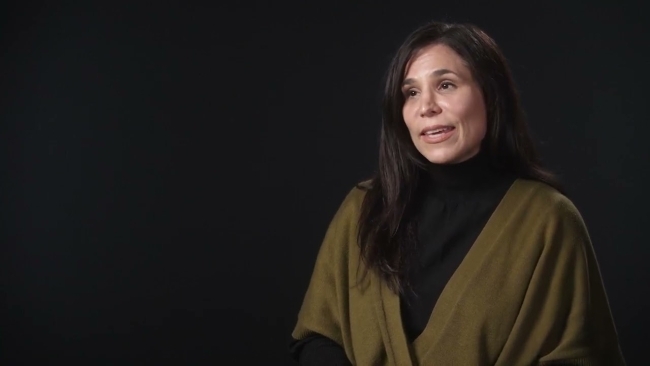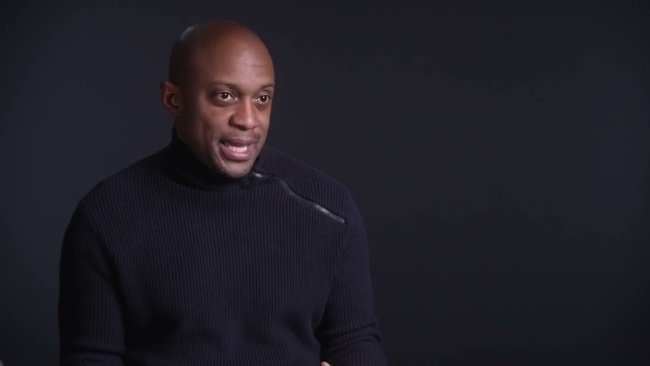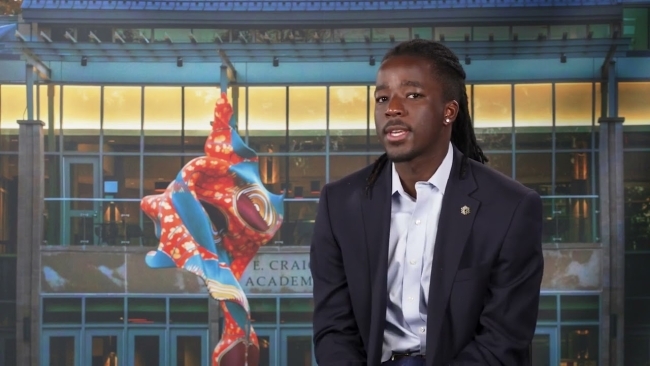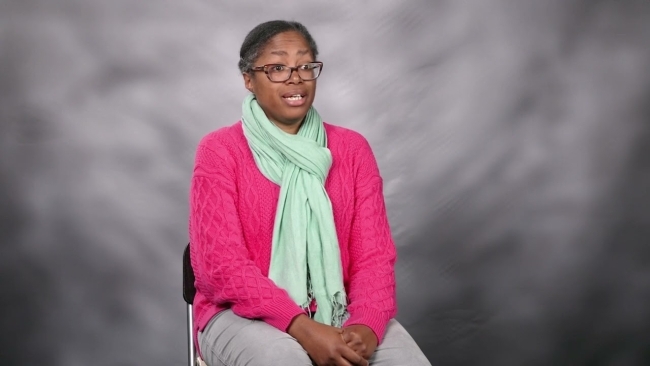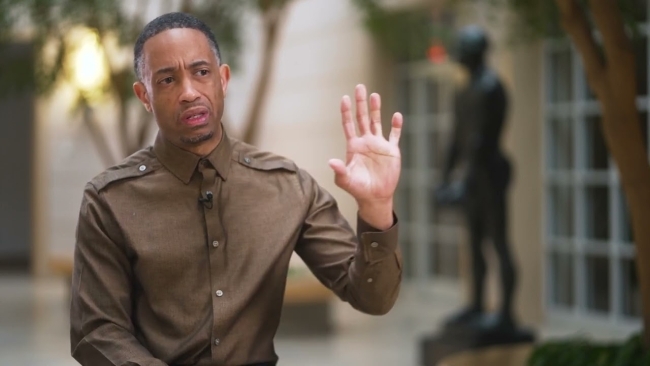Davidson College Unveils Plans for Memorial to Honor the Enslaved and Exploited
March 29, 2023
- Contact
- Mark Johnson
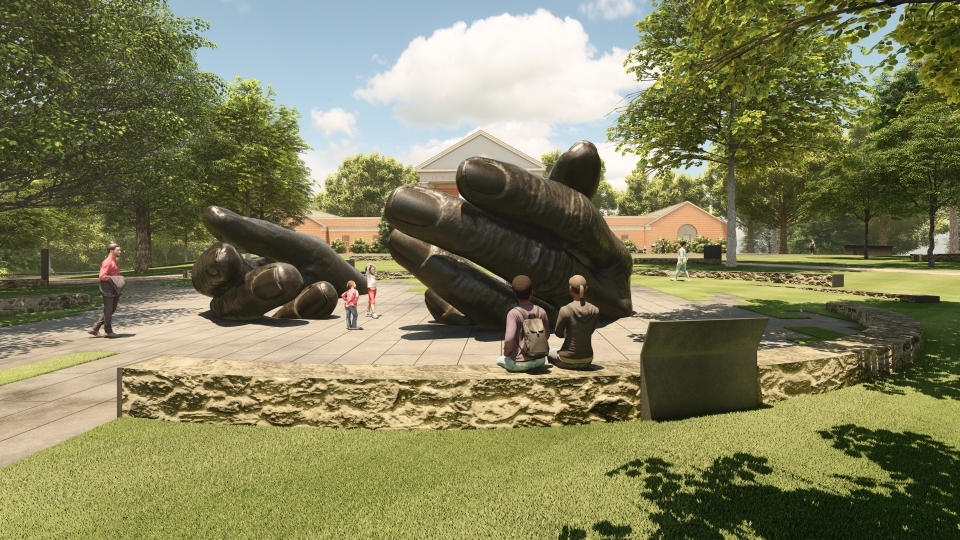
With These Hands by Hank Willis Thomas emerges at the heart of the site, creating space for contemplation and reverence.
Competition concept rendering by Perkins&Will in collaboration with Hank Willis Thomas.
Dedication Ceremony
On Oct. 23, 2025, hundreds of people gathered between buildings built from bricks bearing the thumbprints of enslaved laborers for a ceremony dedicating a new memorial in their honor. With These Hands: A Memorial to the Enslaved and Exploited serves as a place to remember and reflect upon those whose labor helped build the college and serve its students and faculty.
The enslaved people who made the bricks for Davidson College’s original buildings, farmed its land, and served its faculty and students nearly two centuries ago received no acknowledgment for their work.
When the Civil War ended slavery, some served as paid employees. Their lives remained intertwined with Davidson as its leaders supported Jim Crow laws that prevented them from voting, owning property and getting an education.
Davidson can never fully atone for that past. However, the college believes these public efforts will help take another step toward reconciling with it. Today, President Doug Hicks announced plans for a memorial to honor the enslaved and exploited people whose labor helped build the college.
The memorial “With These Hands” will encourage reflection and conversation, says Davidson College President Doug Hicks ’90. He envisions a place for pilgrimage, a sacred site that can encourage visitors to explore the meaning of membership in our community.
Davidson has selected artist Hank Willis Thomas to create the sculpture “With These Hands: A Memorial to the Enslaved and Exploited.” The concept was developed in collaboration with the North Carolina practice of global architectural firm Perkins&Will, who conceived an intentional place of refuge that responds to and surrounds the artwork. The bronze sculpture—two large, work-worn hands—will stand prominently on the lawn near the original Oak and Elm buildings and be visible from Main Street.
“This is a very kind of important time in American history where we are actually learning how to reconcile with the past, especially not the prettiest and most honorable parts of the past,” Thomas said. “And the way we do that in education, the way we do that in storytelling in the media, but also in physical space, is really unprecedented, right? Where we are looking unflinchingly back in the mirror of American history. And to have a college…to be taking a step like this, so unflinchingly, and I think it’s almost a call to action for cities and colleges and universities and libraries across the country to really acknowledge the lives that were sacrificed and exploited so that we get to have the luxuries that we do today.”
Artist Hank Willis Thomas has created a sculpture meant for this moment in American history; when colleges, universities and other American institutions are reconciling with the least honorable parts of their pasts.
“It’s a place of refuge, a place of honor, to commemorate, to grieve, to celebrate and to be accountable,” college Trustee and Commemoration Committee Chair Virgil Fludd ’80 said. “The hands transcend Davidson, from its beginnings to today to the future. They could be the hands used to construct Oak and Elm. They could be the hands that took care of the first students at Davidson. They could be the hands that took care of me in 1976 or could be the hands used to take care of students today and in the future.”
The creation of the memorial “With These Hands” is another step toward reconciling with the past. Davidson College Trustee and Commemoration Committee Chair Virgil Fludd ’80 says it’s time to recognize and honor the enslaved persons whose labor helped to build the college.
The memorial comes as the college examines a history of slavery and discrimination shared by many institutions across the United States. In 2020, then-President Carol Quillen publicly apologized for the college’s past actions. Davidson’s Commission on Race and Slavery, whose research preceded the apology, issued recommendations that include a memorial.
“What’s important is to pay homage and to give credit to them,” Fludd said. “There are buildings named for people who did less, not only at Davidson but around the country. Honoring the people who created the institution we endear—that we care so much about—is the very least we could do.”
Importance of Commemoration
At the University of Alabama, Hilary Green created the “Hallowed Grounds” project, which includes a walking tour of slavery’s history on that campus. She first came to Davidson as a visiting professor in 2020 and worked closely with the race and slavery commission.
She’s now the James B. Duke Professor of Africana Studies specializing in African American history, the Civil War and Reconstruction. She and her students have researched the Black people first enslaved and later employed by the college. They’ve explored their humanity, filling out details of their lives through public records, cemetery visits, letters and diaries.
The memorial to the enslaved and exploited will draw people to a space with an often unacknowledged history. James B. Duke Professor of Africana Studies Hilary Green says the memorial will create space for engagement with Davidson College’s history in a location that is sacred.
“When I first walked across this campus, I could tell where slavery existed, it’s like the air changed in that space,” Green said. “By putting the memorial where enslaved people labored, we are also recognizing the grounds that they helped shape, and the landscapes they maintained.
“We must acknowledge that honestly and truthfully, to hear the voices of people who came before us and who were far too long excluded. Commemoration is an apology; it’s about acknowledging that this was wrong so that we can build a better present and future.”
Davidson has been especially thoughtful in its actions, said Perkins&Will architect Malcolm Davis.
The planned memorial to the enslaved and exploited on the Davidson College campus will be close to Main Street and accessible to the citizens of Davidson whose ancestors may have labored at the college, says Malcolm Davis of architectural firm Perkins&Will.
“Other institutions are embarking on similar endeavors, but I give Davidson a lot of credit for the way they’ve gone about this as a process,” Davis said. “There is something to be learned by the way Davidson has proceeded. Engaging alumni and others to be part of the planning is a fantastic way to come at this work. We have felt that sincerity from the alumni organizations and from the artistic community. They’ve been very intentional about wanting to make sure that the teams are diverse, and that everyone sitting at the table is authentic.
“There’s so much support for getting this right.”
What The Memorial Means
The College of William & Mary took on a similar accounting process more than a decade ago and last year unveiled its memorial to the enslaved workers who once toiled there. History Professor Jody Allen is the Robert Francis Engs Director of the Lemon Project, which “builds bridges between William & Mary and African American communities through research, programming, and supporting students, faculty and staff.”
Allen is an expert on commemoration efforts across the United States.
“Acknowledgement is extremely important,” Allen said. “We must acknowledge them as human beings with lives and desires and dreams. Their contributions helped build this country and these institutions. They need to be remembered. When we fail to acknowledge their history, and the history of slavery, we allow the country to be miseducated.”
While an increasing number of colleges have recognized that they benefitted from slavery, she said, only a few have built memorials. Besides William & Mary, others include the University of Virginia, UNC-Chapel Hill and Brown University. Nationally, commemoration efforts have earned support and met with backlash.
“There’s a concern that learning African American history will damage our country—nothing is further from the truth,” Allen said at William &Mary’s memorial ceremony last May. “We’ve tried ignoring it and look how that worked out. If this country is to move forward, we must tell the truth. This country can be redeemed but it must remember.
"We will no longer ignore the past because we understand willful ignorance hinders progress."
More to Be Done
Davidson’s first Black students came from Africa during the Civil Rights movement of the 1960s and were followed, in very small numbers, by Black Americans. While some students pressured the college to diversify, others objected to integration.
Fludd, a South Carolina native, was one of the few Black students on campus when he arrived in 1976. He led the nearly two-year process that culminated in the selection of “With These Hands.”
Fludd said he often felt like he didn’t belong and considered leaving. That he’s now a college trustee, he said, represents how much Davidson has evolved.
“Davidson back then was a far different place,” Fludd said. “It was not the warm, welcoming diverse environment that it is today.”
Artist Tyler Yvette Wilson ’14, describes her Davidson experience as positive, and the college community as supportive. She now teaches at Wesleyan College in Macon, Georgia. Her art often focuses on the exploitation of Black and Brown communities and has appeared in multiple public venues, including on highway billboards in Baltimore’s art district.
Wilson, a college Art Collection Advisory Committee member, served on the commemoration jury. She said the college has come a long way in diversifying its exhibits and striving for equitable representation. Choosing from the five finalists was difficult.
“These are artists I’m a huge fan of,” Wilson said. “It was so cool to be in a room and meet my artistic heroes.”
The biggest influence, she said, was the profound impact that Thomas’s work had on several others in the group.
“That was enough for me,” she said, adding, “I adore his work and I’m excited to have an artist of his stature creating the monument at Davidson.”
Tackling important issues through public art can invite controversy, and many institutions shy away from it, Wilson said.
“What Davidson is doing is very courageous. You see a lot of colleges put something on a website and that’s the end of it. To make a declaration of this magnitude—of this permanence—and invest in it financially is huge,” Wilson said. “This is not performative, it’s taking real steps to rectify what happened in the past, and that takes a lot of guts.”
Lifelong Davidson resident Bernetta Graham also served on the jury that recommended Thomas’s sculpture. She hopes it will prompt discussions about what transpired and inspire new efforts to help Black residents who still struggle from the legacy of slavery and discrimination.
“This is a start,” Graham said. “I liked the idea of the Black hands, because Black hands built the college. It’s important that it’s open to the community. So many of our children don’t know about slavery and don’t understand what was done to our people. Hopefully this will be educational, to let them know where they came from, and where they can go in the future.”
Fludd said he wants the memorial to be a lasting symbol to remember the college’s past, and its promise going forward.
“I want it to be a boomerang, not just a one-time experience, but where people feel compelled to learn more,” Fludd said. “The college should feel like it’s made a tremendous statement, that it has brought to light things that were not exposed or revealed in the past and that there’s more work to be done.
“This is not the end.”
